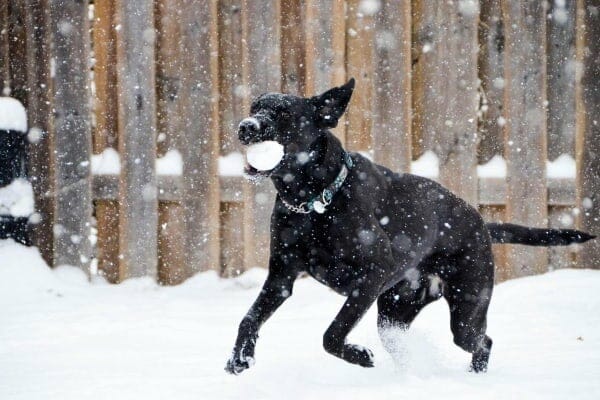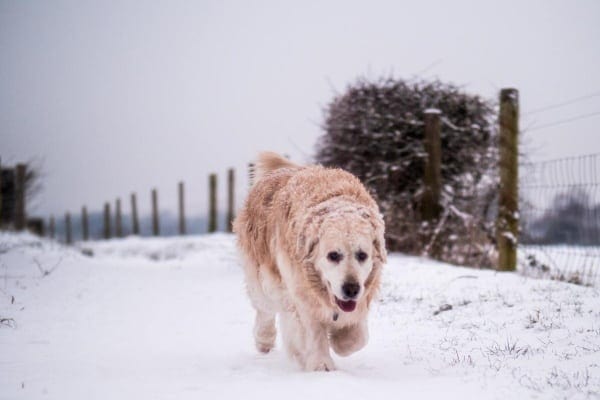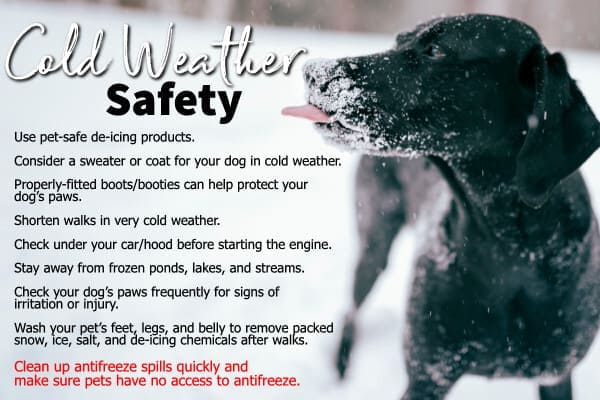With freezing temperatures fast approaching, you may be wondering about special precautions you should take for your dogs and cold weather. Older pups, especially toy or thin-coated breeds, sometimes need help staying warm when it’s chilly. Integrative veterinarian Dr. Julie Buzby answers common questions about keeping dogs safe and comfortable in the cold weather this winter.

- How does cold weather affect dogs?
- 1. What temperature is too cold for dogs?
- 2. Do older dogs get cold easier?
- 3. How can I tell if my dog is cold?
- 4. Does cold weather affect arthritis in dogs?
- 5. Can dogs get sick from cold weather?
- 6. Does cold weather make my dog more susceptible to other health problems?
- 7. How long can a dog be in the snow?
- 8. Do dogs' feet get cold in the snow?
- 9. Can dogs get frostbite on their paws in the snow?
- 10. How do you know if a dog is cold at night?
- An important note about antifreeze and dogs
- Baby, it's cold outside
- What do you love about winters with your senior dog?
As the temperatures drop where you live this winter, are you and your dog beginning to exchange “the look” when it’s time to go out? You know the one…the expression that has you both asking, “Isn’t it too cold for this?”
Just like you and me, extreme temperatures and wind chill impact your dog’s enthusiasm to spend time outside. But can cold weather also cause harm to your beloved dog?
Absolutely.
So before you bundle up to head outside with your canine companion, let’s take a closer look at how cold weather can affect them, and how we can help keep dogs warm in winter.
How does cold weather affect dogs?
Just as hot weather can increase risk for dangers such as heat stroke in dogs, cold weather comes with its own set of concerns that we should be aware of.
Many dogs love playing in the cold and snow, but not all of them are built to tolerate low temperatures for long periods of time. Many of the things we think about with people and exposure apply to dogs as well. While severe conditions such as hypothermia and frostbite occur rarely, we want to make sure our furry friends are safe and healthy in the winter weather. Don’t let your dog spend too much time exposed to extreme cold.

Let’s take a look at the top ten most common questions I get asked about dogs and cold weather.
1. What temperature is too cold for dogs?
How cold is too cold?
I wish it were as easy as sharing an exact temperature below which your dog may be at risk. There is no one size fits all for temperature safety. Many factors impact your dog’s ability to tolerate the cold. These include breed, age, weight, body fat (aka canine body condition score), hair coat, and health status.
There’s also the issue of acclimation—what temperature norms your dog is used to. The year our family moved from Pennsylvania to South Carolina, we were amused witnessing how our neighbors handled 40 degree weather. They would don their arctic gear to walk their dogs or retrieve their mail. Meanwhile, my husband was gleefully running around outside in a T-shirt and shorts because he had endured snow-filled, sub-freezing winters all his life.
The same holds true for our pets. A healthy Husky dog who is used to chilly temperatures will fare significantly better in cold weather than a grey-muzzled Greyhound who is used to life in sunny San Diego.
2. Do older dogs get cold easier?
This is another question that I like to draw comparisons between dogs and people. During especially bad cold snaps, we worry most about babies and the elderly. The very old and very young are especially vulnerable to very cold temperatures; they can’t regulate their body temperatures well. The same holds true for dogs.

Older dogs are generally less tolerant of the cold than their younger, robust counterparts. Keep in mind, however, that once temperatures drop into the teens, it’s dangerous for all dogs regardless of age.
Even if your senior dog has tolerated the tundra for the last 10 years, he or she may need some extra help staying warm as time progresses.
3. How can I tell if my dog is cold?
Common sense prevails! If your dog is standing on the sidewalk shivering, then he’s cold!
Signs that your dog may be too cold can include:
- Shaking or shivering
- Reluctance to move
- Ice on his or her coat
- Lifting his or her paws intermittently
- Vocalizing or whining
- Hunched posture
- Tail tucking
- Seeming restless or trying to find shelter
Granted, there are plenty of other reasons an old dog may shake and shiver, but if you’re out in the elements and your dog is shivering, get him or her somewhere warmer!
4. Does cold weather affect arthritis in dogs?
Again, I draw a comparison to people. I know when it gets colder I can definitely feel some of my old orthopedic injuries making themselves known. Does cold weather affect joints in dogs? Absolutely.

Stiffening of arthritic joints
Arthritic joints can become more stiff and painful in cold weather. Making a concerted effort to intentionally protect your senior dog from the cold will translate into a more comfortable winter for your dog.
Even dogs who don’t normally show signs of arthritis may become stiff when it’s colder out. Making sure they have a nice warm bed, maybe even a sweater if they’ll tolerate it, can help keep them warm and decrease arthritic pain.
5. Can dogs get sick from cold weather?
“Put on your coat or you’ll catch a cold!”
Anyone else’s mom say this about them 43 times every winter? Well, we know now that we get sick from viruses and bacteria, not from cold weather.
However, it’s also true that stress (physiologic stress, not just trying to meet a deadline stress) can suppress the immune system. So while the cold itself won’t cause illness, it can make the body more susceptible to infections that it otherwise would have been able to fight off.
Dogs with other underlying health conditions may have more trouble dealing with colder temperatures, and exposure may worsen chronic health conditions in some cases.
Dogs can also get very sick from hypothermia. Exposure to extreme cold for too long can cause organ dysfunction that, in the worst cases, can be fatal. If your dog shows signs of hypothermia (especially if he or she seems lethargic or sluggish), get your pup inside and then to your vet right away!

6. Does cold weather make my dog more susceptible to other health problems?
It most certainly can! Here are a few of the ones I encounter frequently.
Slips and injuries
When my mom was nearing retirement age, she slipped and fell on the ice outside of the school where she taught. It took a huge toll on her body (and her confidence)!
Injury is a primary concern for senior dogs who are out walking, running, and playing in cold winter weather. This is because, like senior humans, senior dogs have slower reflexes and less balance than dogs in the prime of youth. They may also be dealing with arthritis and joint stiffness.
One solution to this issue may be our company’s signature product, Dr. Buzby’s ToeGrips®. ToeGrips help dogs maintain traction, so they can be lifesavers in icy conditions! I love hearing from ToeGrips customers about how their senior dogs are getting around much more easily.
I am very happy to report that your ingenious invention is working wonders for Pepper, our 10-year-old, three-legged cancer survivor. As I watched him carefully this morning for the full 80-minute walk, I was amazed at his ability to stay upright. He never fell once!
I knew all the slick spots and watched him yesterday (without the ToeGrips) and his poor hip bones went crashing to the ground every time that hind leg slipped. Today, with the ToeGrips, he rarely slid, and never fell. When he walked over pure ice, his foot would begin to slide, then the grips “gripped” and kept him upright!
Today, I saw a patch of ice and walked around it; Pepper walked right over it, started to slide, then got a grip. That is amazing. Pepper has been falling on the icy hard-packed snow, and now he is not! Thank you so much!
Joanne, ToeGrips customer
ToeGrips are not designed to be wintertime paw protectors, but they may help dogs walk on slick surfaces outdoors, just as they help senior dogs from slipping on hard surface floors inside.

Higher risk of IVDD
Research has shown that there is also a greater incidence of IVDD (intervertebral disc disease) in cold weather.
Especially in dogs already at higher risk of IVDD, one wrong slip on ice or snow may cause them to throw out their backs. We want to be especially cognizant of protecting at-risk breeds like Dachshunds, Corgis, etc.
Can my dog get hives from the cold weather?
As crazy as it sounds, the answer is yes. Typically, hives appear after exposure to an allergen such as peanuts or an insect bite. But there is another little known cause of hives in humans — cold weather. This condition is known as cold-induced urticaria. (Urticaria is the medical term for hives.)
This rare, but legitimate phenomenon occurs in dogs, too. Treatment involves keeping the dog warm and administering an oral antihistamine like Benadryl as needed.
7. How long can a dog be in the snow?
Just like the temperature, there is no exact “one size fits all” number for time limits. Your dog’s breed, age, size, acclimation to snow, etc. all play a role in their snow tolerance.
Generally speaking, watch for signs of cold listed above, and make sure your dog has a way to get out of the snow whenever he or she chooses to do so. Even Siberian Huskies running the Iditarod need a break sometimes!
8. Do dogs’ feet get cold in the snow?
Dogs’ paws can be very sensitive to extreme temperatures. When it’s hot out, I encourage owners to do the sidewalk test. If the pavement is too hot for you to hold your hand on, it’s too hot for your dog to walk on.
I don’t know about you, but I am not willing to go out in the snow in bare feet. Your dog may not be either! Pay attention to his or her cues. If you see them holding a paw up, it’s probably because it’s uncomfortably cold.

I know a lot of dogs LOVE to play in the snow. When we lived in “cold country,” I always made sure there was a “time out” space where my dog could get out of the snow and take a break if he chose to. It wasn’t anything fancy. My go-to was a shoveled square of sidewalk with a piece of cardboard thrown down on top of it.
9. Can dogs get frostbite on their paws in the snow?
Though frostbite can occur on a dog’s paws, it’s pretty rare. More often than not, dogs are able to play in the snow for a reasonable amount of time without suffering any ill effects.
How is this possible? The secret lies in the makeup of your dog’s paws—specifically, the thick fat paw pads which are considerably more “freeze resistant” than his other body tissue. The paw pads also possess a mechanism called the counter-current heat exchange which helps the paw temperature stay within a normal range.
That being said, other extremities such as the ears, nose, and tip of the tail are still susceptible to frostbite. Be sure to take care and not leave your dog exposed to freezing temperatures for too long.
What are the best dog boots for cold weather and snow?
Generally speaking, I dislike dog boots, and I never recommend them for traction. Dog boots and booties interfere with your dog’s ability to “feel” the ground with his paws and disable much of the natural proprioceptive input from the many receptors in his toes.
However, I will admit that dog boots are the practical solution if you desire to protect the paw pads and lower legs from ice melt, salt, and other harsh chemicals.
As long as the boot fits snug (but not too tight!), covers the paw, and stays in place while your dog runs or walks, it fits the bill for this application. I don’t specifically recommend one brand over another for protection from winter elements.
Whatever you decide about your dog’s footwear, please take the time to visually and manually inspect your dog’s paws after every outdoor outing. It should just take a moment to run your hand over each paw and feel for ice or snow chunks lodged in the fur.
10. How do you know if a dog is cold at night?
Many of the same signs listed above apply at night as well. Your dog may shiver, seem restless, etc. if he or she is cold.

If your dog is usually a sleep champion but has difficulty sleeping through the night during winter, low temperatures may be the culprit.
You may notice your dog seeking out warmer areas to lay at night if he or she is cold. I like to buy cheap fleece throws in the fall to layer onto my dog’s bed for extra warmth.
If you have more than one dog, they may sleep next to each other, or next to you, for extra warmth if they’re chilly.
Just remember that activity and movement increase body temperature. At night, we are still, so our bodies can get colder than when we are awake. Just because your dog is comfortable at a certain temperature during the day doesn’t mean it’s the right temperature at night. By paying attention to the cues, you’ll be helping your dog.
An important note about antifreeze and dogs
While on the subject of dogs and winter weather, it’s extremely important to call out another winter hazard for dogs: antifreeze poisoning.
If I could, I would put flashing neon lights around this section on the dangers of antifreeze poisoning.
To illustrate the dangers of antifreeze, I share a memory I’ll never forget. In veterinary school, one of my classmate’s dogs was exposed to antifreeze at the farm where she kept her horse.
I don’t remember all the details, but I remember the dog didn’t respond to the treatment for antifreeze poisoning because the dog’s owner discovered the truth too late. So she chartered a small plane on a moment’s notice to fly her dog to a specialty care facility. She spent tens of thousands of dollars trying to save her dog, and her poor pup passed away anyway. So devastating.
Antifreeze is a sweet-tasting temptation; even a few licks can be fatal. Should your dog ingest antifreeze, it’s a serious veterinary emergency where minutes count.
The active ingredient in antifreeze is called ethylene glycol. It’s absorbed very quickly in the bloodstream where it then travels to the liver and is broken down. This is where the danger lies—the byproduct of that breakdown process shuts down the dog’s kidneys.
There is treatment, but treatment must begin within 8-12 hours after ingestion to be successful. If you suspect your dog has licked or consumed antifreeze, head immediately to your veterinarian or local veterinary emergency facility for diagnostic testing and treatment.

Baby, it’s cold outside
When cold temperatures and freezing precipitation strike, we want to make sure to keep our senior dogs comfortable. But that doesn’t mean you can’t sensibly enjoy the fun things the season brings. Enjoy the coming winter months with your four-legged companion—but as you do, let these cold weather safety tips be your guide.
What do you love about winters with your senior dog?
Share in the comments below. We’d love to hear!


My geriatric 14yo standard poodle has been dragging his back toenails a bit on sidewalks sometimes resulting in his toenails being too short and bleeding. Now when I walk him I wrap his back feet in vet wrap tape and his toenails don’t get too worn down. As an added bonus his feet don’t hurt from the salt or ice crystals getting between his toes.
Hi Tina,
This is a great solution! Vet wrap for the win! Thank you for sharing this bit of information with us. Keep up the good work.
I just rescued 2 chiwahua s. One 3# ,one 6#,s. How should I get them to go potty in raining or otherwise cold weather?
Hi Nola,
I wish there was a straightforward answer to this question. Unfortunately, each dog is different, and it can be hard to know what will work. Small dogs may be more comfortable with a sweater or jacket on to help keep them warm. They may have a preference as to what kind of surface they are standing on. Some dogs don’t mind walking out on hard ground but will avoid wet grass on their feet. If they refuse to go out when raining, you might be able to provide a small, covered area for them to potty or have to hold an umbrella for them (how involved are you willing to get?). Dogs can learn to do many things with the encouragement of praise and treats if they are food motivated. Pee pads are also a great resource for allowing small dogs to potty inside as long as this is something you are comfortable with. I am hopeful you will find what works best for you and your pups. Wishing you much success!
In cold weather, would the dog’s testicles shrink & would he lose libido? My rescued pit bull of possibly 10 years stopped sexual activities with pillows since arriving in NV 2 months ago. It’s been cold most days, 20 degrees. His testicles were noticeably smaller.
Hi Bridgitte,
I am not sure I have definite answers for you. It is hard to make specific conclusions without examining your dog myself. I will say that all male dogs have muscles present in the scrotum. These muscles can contract, pulling the testicles closer to the body, or relax allowing the testicles to move further away from the body. These changes allow for temperature regulation. So, it would be normal for a dog’s testicles to appear closer to the body during periods of cold weather. I am not sure how this would affect libido or why your pup has stopped some of his hormone driven behaviors. If you have any concerns about his health or wellbeing, I highly recommend you have him evaluated by your vet.
thank you so much for all n great update on our fur babies, my Sadie past looking for another one to adopt from Human S ,love your help!♥️🙏